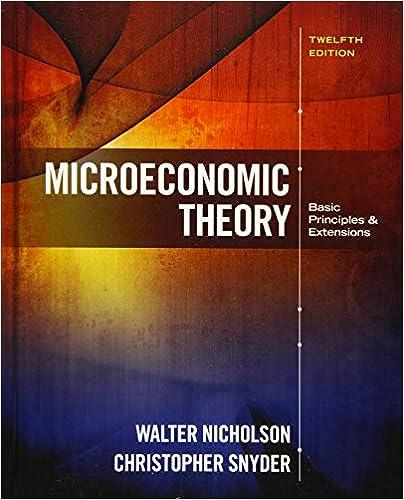Intertemporal labor supply It is relatively easy to extend the single-period model of labor supply presented in
Question:
Intertemporal labor supply It is relatively easy to extend the single-period model of labor supply presented in Chapter 16 to many periods.
Here we look at a simple example. Suppose that an individual makes his or her labor supply and consumption decisions over two periods.14 Assume that this person begins period 1 with initial wealth W0 and that he or she has 1 unit of time to devote to work or leisure in each period.
Therefore, the two-period budget constraint is given by W0 5 c1 1 c2 2 w1 11 2 h12 2 w2 11 2 h22, where the w’s are the real wage rates prevailing in each period. Here we treat w2 as uncertain, so utility in period 2 will also be uncertain. If we assume utility is additive across the two periods, we have E 3U 1c1, h1,c2, h22 4 5 U 1c1, h12 1 E 3U 1c2, h22 4.
a. Show that the first-order conditions for utility maximization in period 1 are the same as those shown in Chapter 16; in particular, show MRS 1c1 for h12 5 w1.
Explain how changes in W0 will affect the actual choices of c1 and h1.
b. Explain why the indirect utility function for the second period can be written as V1w2, W∗2, where W∗ 5 W0 1 w1 11 2 h12 2 c1. (Note that because w2 is a random variable, V is also random.)
c. Use the envelope theorem to show that optimal choice of W∗ requires that the Lagrange multipliers for the wealth constraint in the two periods obey the condition λ1 5 E 1λ22 1where λ1 is the Lagrange multiplier for the original problem and λ2 is the implied Lagrange multiplier for the period 2 utility-maximization problem2 . That is, the expected marginal utility of wealth should be the same in the two periods. Explain this result intuitively.
d. Although the comparative statics of this model will depend on the specific form of the utility function, discuss in general terms how a governmental policy that added k dollars to all period 2 wages might be expected to affect choices in both periods.
Step by Step Answer:

Microeconomic Theory Basic Principles And Extensions
ISBN: 9781305505797
12th Edition
Authors: Walter Nicholson, Christopher M. Snyder






